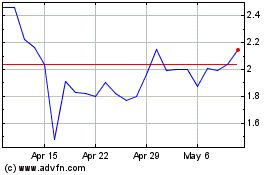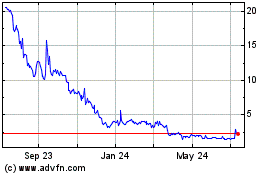180 Life Sciences Corp. Enters into a License Agreement with University of Oxford for Regenerative Molecule HMGB1 for Liver Diseases
December 15 2021 - 8:15AM

180 Life Sciences Corp. (NASDAQ: ATNF) (“180 Life Sciences” or the
“Company”), a clinical-stage biotechnology company focused on the
development of novel drugs that fulfill unmet needs in inflammatory
diseases, fibrosis and pain, today announced that it has
entered into a new, exclusive global licensing agreement with The
University of Oxford (“Oxford”) for the development and
commercialization of HMGB1, a regenerative molecule for promoting
liver repair and regeneration. Under the terms of the transaction,
the Company will pay Oxford a small one-time upfront license fee,
which will have an insignificant impact on the 2022 expenditure
rate; and any further payments are contingent upon the achievement
of certain clinical, regulatory and sales milestones.
There is currently no approved therapeutic for limiting damage
and fibrosis in patients with liver disorders such as Non-Alcoholic
Steatohepatitis (“NASH”). 180 Life Sciences, through a
collaboration led by Professor Jagdeep Nanchahal at the University
of Oxford, is pursuing a program to identify novel therapeutic
targets. The team has identified a physiological pathway, activated
by the molecule HMGB1, that has been shown to lead to regeneration
of tissues by targeting endogenous stem and progenitor cells.
Together with the University of Oxford, the Company plans to
proceed with scaling up and Good Manufacturing Practice (GMP)
production, as well as safety and toxicity testing in preparation
for a planned Investigational New Drug (IND) application
filing.
According to a 2016 article by Rinella, M.E. and A.J. Sanyal,
entitled, “Management of NAFLD: a stage-based approach”, published
in the Naturel Reviews Gastroenterol Hepatol, non-alcoholic fatty
liver disease (NAFLD) has emerged as the most common cause of
chronic liver condition in the Western world, affecting 30% of the
adult population in the USA and encompassing non-alcoholic fatty
liver (NAFL) and non-alcoholic steatohepatitis (NASH). NAFL and
NASH each carries significant morbidity and mortality risks; 2-3%
NAFL and 15-20% NASH patients progress to cirrhosis, with some
developing hepatocellular carcinoma.
Dr. James Woody, CEO of 180 Life Sciences, commented, “Liver
diseases represent a large unmet medical need. NASH is expected to
become the principal indication for liver transplantation in the
USA, with the attendant problems of immunosuppression and shortages
of suitable donors. We believe an effective treatment that promotes
regeneration and limits hepatocellular damage and fibrosis has the
potential to revolutionize the management of patients.”
About 180 Life Sciences Corp.
180 Life Sciences Corp. is a clinical-stage biotechnology
company focused on the development of novel drugs that fulfill
unmet needs in inflammatory diseases, fibrosis and pain by
leveraging the combined expertise of luminaries in therapeutics
from Oxford University, the Hebrew University and Stanford
University. 180 Life Sciences is leading the research into solving
one of the world’s biggest drivers of disease – inflammation. The
Company is driving groundbreaking studies into clinical programs,
which are seeking to develop novel drugs addressing separate areas
of inflammation for which there are no effective therapies. The
Company’s primary platform is a novel program to treat fibrosis
using anti-TNF (tumor necrosis factor).
Forward-Looking Statements
This press release includes "forward-looking statements",
including information about management’s view of the Company’s
future expectations, plans and prospects, within the safe harbor
provisions provided under federal securities laws, including under
The Private Securities Litigation Reform Act of 1995 (the “Act”).
Words such as “expect,” “estimate,” “project,” “budget,”
“forecast,” “anticipate,” “intend,” “plan,” “may,” “will,” “could,”
“should,” “believes,” “predicts,” “potential,” “continue” and
similar expressions are intended to identify such forward-looking
statements. These forward-looking statements involve significant
risks and uncertainties that could cause the actual results to
differ materially from the expected results and, consequently, you
should not rely on these forward-looking statements as predictions
of future events. These forward-looking statements and factors that
may cause such differences include, without limitation, the
uncertainties associated with the clinical development and
regulatory approval of 180 Life Science’s drug candidates,
including potential delays in the enrollment and completion of
clinical trials; the potential that earlier clinical trials and
studies may not be predictive of future results; 180 Life Sciences’
reliance on third parties to conduct its clinical trials, enroll
patients, and manufacture its preclinical and clinical drug
supplies; unexpected adverse side effects or inadequate therapeutic
efficacy of drug candidates that could limit approval and/or
commercialization, or that could result in recalls or product
liability claims; 180 Life Sciences’ ability to fully comply with
numerous federal, state and local laws and regulatory requirements,
as well as rules and regulations outside the United States, that
apply to its product development activities; the timing of filing,
the timing of governmental review, and outcome of, planned
Investigational New Drug (IND) applications for drug candidates;
current negative operating cash flows and a need for additional
funding to finance our operating plans; the terms of any further
financing, which may be highly dilutive and may include onerous
terms; statements relating to expectations regarding future
agreements relating to the supply of materials and license and
commercialization of products; the availability and cost of
materials required for trials; the risk that initial drug results
will not be able to be replicated in clinical trials or that such
drugs selected for clinical development will not be successful;
challenges and uncertainties inherent in product research and
development, including the uncertainty of clinical success and of
obtaining regulatory approvals; uncertainty of commercial success;
the inherent risks in early stage drug development including
demonstrating efficacy; development time/cost and the regulatory
approval process; the progress of our clinical trials; our ability
to find and enter into agreements with potential partners; our
ability to attract and retain key personnel; changing market and
economic conditions; our ability to produce acceptable batches of
future products in sufficient quantities; unexpected manufacturing
defects; manufacturing difficulties and delays; competition,
including technological advances, new products and patents attained
by competitors; challenges to patents; product efficacy or safety
concerns resulting in product recalls or regulatory action; changes
in behavior and spending patterns of purchasers of health care
products and services; changes to applicable laws and regulations,
including global health care reforms; expectations with respect to
future performance, growth and anticipated acquisitions; the
continued listing of the Company on The NASDAQ Stock Market;
expectations regarding the capitalization, resources and ownership
structure of the Company; expectations with respect to future
performance, growth and anticipated acquisitions; the ability of
the Company to execute its plans to develop and market new drug
products and the timing and costs of these development programs;
estimates of the size of the markets for its potential drug
products; the outcome of current litigation involving the Company;
potential future litigation involving the Company or the validity
or enforceability of the intellectual property of the Company;
global economic conditions; geopolitical events and regulatory
changes; the expectations, development plans and anticipated
timelines for the Company's drug candidates, pipeline and programs,
including collaborations with third parties; access to additional
financing, and the potential lack of such financing; and the
Company’s ability to raise funding in the future and the terms of
such funding. These risk factors and others are included from time
to time in documents the Company files with the Securities and
Exchange Commission, including, but not limited to, its Form 10-Ks,
Form 10-Qs and Form 8-Ks. These reports and filings are available
at www.sec.gov. All subsequent written and oral forward-looking
statements concerning the Company, the results of the Company’s
clinical trial results and studies or other matters and
attributable to the Company or any person acting on its behalf are
expressly qualified in their entirety by the cautionary statements
above. Readers are cautioned not to place undue reliance upon any
forward-looking statements, which speak only as of the date made,
including the forward-looking statements included in this press
release, which are made only as of the date hereof. The Company
cannot guarantee future results, levels of activity, performance or
achievements. Accordingly, you should not place undue reliance on
these forward-looking statements. The Company does not undertake or
accept any obligation or undertaking to release publicly any
updates or revisions to any forward-looking statement to reflect
any change in its expectations or any change in events, conditions
or circumstances on which any such statement is based, except as
otherwise provided by law.
Investors:
Jason AssadDirector of IR180 Life Sciences Corp(678)
570-6791Jason@180lifesciences.com
Media Relations:
Russo PartnersDavid
SchullDavid.Schull@russopartnersllc.com (212)
845-4271
180 Life Sciences (NASDAQ:ATNF)
Historical Stock Chart
From Mar 2024 to Apr 2024

180 Life Sciences (NASDAQ:ATNF)
Historical Stock Chart
From Apr 2023 to Apr 2024
